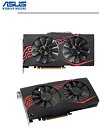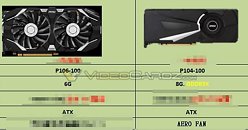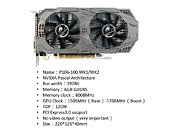- Joined
- Oct 9, 2007
- Messages
- 47,649 (7.44/day)
- Location
- Dublin, Ireland
| System Name | RBMK-1000 |
|---|---|
| Processor | AMD Ryzen 7 5700G |
| Motherboard | Gigabyte B550 AORUS Elite V2 |
| Cooling | DeepCool Gammax L240 V2 |
| Memory | 2x 16GB DDR4-3200 |
| Video Card(s) | Galax RTX 4070 Ti EX |
| Storage | Samsung 990 1TB |
| Display(s) | BenQ 1440p 60 Hz 27-inch |
| Case | Corsair Carbide 100R |
| Audio Device(s) | ASUS SupremeFX S1220A |
| Power Supply | Cooler Master MWE Gold 650W |
| Mouse | ASUS ROG Strix Impact |
| Keyboard | Gamdias Hermes E2 |
| Software | Windows 11 Pro |
GPU-accelerated crypto-currency mining poses a threat to the consumer graphics industry, yet the revenues it brings to GPU manufacturers are hard to turn away. The more graphics cards are bought up by crypto-currency miners, the fewer there are left for gamers and the actual target-audience of graphics cards. This is particularly bad for AMD, as fewer gamers have Radeon graphics cards as opposed to miners; which means game developers no longer see AMD GPU market-share as an amorphous trigger to allocate developer resources in optimizing their games to AMD architectures.
To combat this, both AMD and NVIDIA are innovating graphics cards designed specifically for crypto-currency mining. These cards are built to a cost, lack display outputs, and have electrical and cooling mechanisms designed for 24/7 operation, even if not living up to the durability standards of real enterprise-segment graphics cards, such as Radeon Pro series or Quadro. NVIDIA's "Pascal" GPU architecture is inherently weaker than AMD's "Polaris" and older Graphics CoreNext architectures at Ethereum mining, owing in part to Pascal's lack of industry-standard asynchronous compute. This didn't deter NVIDIA from innovating a lineup of crypto-mining SKUs based on its existing "Pascal" GPUs. These include the NVIDIA P104 series based on the "GP104" silicon (on which the GTX 1080 and GTX 1070 are based); and P106 series based on the "GP106" silicon (GTX 1060 series is based on this chip). NVIDIA didn't tap into its larger "GP102" or smaller "GP107" chips, yet.




VideoCardz compiled a small list of unreleased crypto-currency mining cards based on the P104 and P106. These include cards from popular NVIDIA GeForce add-in card (AIC) partners, such as ASUS, MSI, and Colorful. The mining-segment cards look almost identical to the GeForce GTX 10-series cards they're derived from; but lack display outputs. Pictured above are the ASUS MINING-P106-6G, MSI P106-Miner, MSI P104-Miner; and Colorful P106-100 WK1 (in that order). It remains to be seen how NVIDIA and its partners price these cards, but if they're pricier than their GeForce GTX siblings, this whole exercise will be rendered futile, as miners will simply buy up the GeForce GTX inventories.
View at TechPowerUp Main Site
To combat this, both AMD and NVIDIA are innovating graphics cards designed specifically for crypto-currency mining. These cards are built to a cost, lack display outputs, and have electrical and cooling mechanisms designed for 24/7 operation, even if not living up to the durability standards of real enterprise-segment graphics cards, such as Radeon Pro series or Quadro. NVIDIA's "Pascal" GPU architecture is inherently weaker than AMD's "Polaris" and older Graphics CoreNext architectures at Ethereum mining, owing in part to Pascal's lack of industry-standard asynchronous compute. This didn't deter NVIDIA from innovating a lineup of crypto-mining SKUs based on its existing "Pascal" GPUs. These include the NVIDIA P104 series based on the "GP104" silicon (on which the GTX 1080 and GTX 1070 are based); and P106 series based on the "GP106" silicon (GTX 1060 series is based on this chip). NVIDIA didn't tap into its larger "GP102" or smaller "GP107" chips, yet.




VideoCardz compiled a small list of unreleased crypto-currency mining cards based on the P104 and P106. These include cards from popular NVIDIA GeForce add-in card (AIC) partners, such as ASUS, MSI, and Colorful. The mining-segment cards look almost identical to the GeForce GTX 10-series cards they're derived from; but lack display outputs. Pictured above are the ASUS MINING-P106-6G, MSI P106-Miner, MSI P104-Miner; and Colorful P106-100 WK1 (in that order). It remains to be seen how NVIDIA and its partners price these cards, but if they're pricier than their GeForce GTX siblings, this whole exercise will be rendered futile, as miners will simply buy up the GeForce GTX inventories.
View at TechPowerUp Main Site













